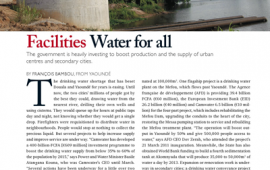Facilities Water for all

The drinking water shortage that has beset Douala and Yaoundé for years is easing. Until now, the two cities’ millions of people got by the best they could, drawing water from the nearest river, drilling their own wells and using cisterns. They would queue up for hours at public taps day and night, not knowing whether they would get a single drop. Firefighters were requisitioned to distribute water in neighbourhoods. People would stop at nothing to collect the precious liquid. But several projects to help increase supply and improve service are under way. “Camwater has developed a 400-billion-FCFA [€609 million] investment programme to boost the drinking water supply from below 35% to 60% of the population by 2015,” says Power and Water Minister Basile Atangana Kouna, who was Camwater’s CEO until March. “Several actions have been underway for a little over two years. We’ve built a drinking water plant on the River Moungo capable of supplying 50,000m3 a day to increase output for Douala. Meanwhile, we repaired and built industrial wells in the city centre and the Massoumbou watershed, boosting the economic capital’s drinking water supply from 105,000 to 180,000m3 a day. We intend to reach 300,000m3 a day by 2013 by expanding the Moungo plant, which is underway.” In Yaoundé, where the hilly terrain makes the situation more complicated during dry spells, officials are carrying out several projects at the same time, building new treatment and pumping stations, rehabilitating existing sites and so on. Demand in the capital is 300,000m3 a day but supply has stagnated at 100,000m3. One flagship project is a drinking water plant on the Mefou, which flows past Yaoundé. The Agence française de développement (AFD) is providing 39.4 billion FCFA (€60 million), the European Investment Bank (EID) 26.2 billion (€40 million) and Camwater 6.5 billion (€10 million) for the four-part project, which includes rehabilitating the Mefou Dam, upgrading the conduits to the heart of the city, restoring the Messa pumping station to service and rebuilding the Mefou treatment plant. “The operation will boost output in Yaoundé by 50% and give 500,000 people access to water,” says AFD CEO Dov Zerah, who attended the project’s 21 March 2011 inauguration. Meanwhile, the State has also obtained World Bank funding to build a fourth sedimentation tank at Akomnyada that will produce 35,000 to 50,000m3 of water a day by 2013. Expansion or renovation work is underway in secondary cities; a drinking water conveyance project in Edéa, Bertoua and Ngaoundéré, jointly funded by the AFD and EID, should be completely finished by 31 December 2013. The World Bank has loaned 14.7 billion FCFA (€22 million) for emergency repairs of existing hydraulic facilities or extending the drinking water distribution network. Belgium’s Dexia Bank (now Belfius) has loaned 39. billion FCFA (€60 million) to help rehabilitate, strengthen and extend the water conveyance systems of around 40 already-equipped centres and to kit out approximately 10 “unequipped” towns. Lastly, the African Development Bank (ADB) has made 22 billion FCFA (€33.5 million) available to improve the water supply in 18 secondary centres.
By François BAMBOU, FROM YAOUNDÉ